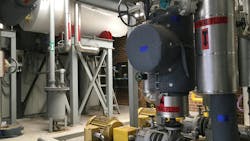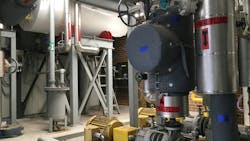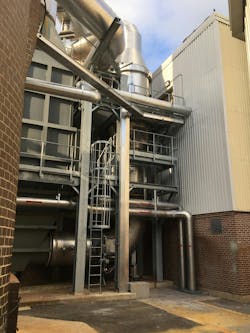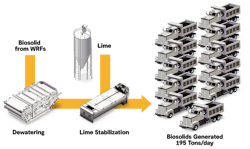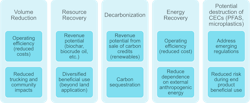The rise of thermal treatment technologies for sludge & biosolids
The biosolids treatment landscape in North America is undergoing a significant transformation. With increasing regulatory pressures, rising costs, and growing environmental concerns, utilities are exploring proven and innovative thermal treatment methods to address biosolids management risks.
Technologies such as incineration, gasification, pyrolysis, supercritical water oxidation (SCWO), and hydrothermal liquefaction are gaining traction and have the potential to revolutionize biosolids management over the next decade.
The need for change
Traditionally, biosolids in North America have been managed through land application and landfill disposal. According to the National Biosolids Data Project, approximately 83% of biosolids produced in the United States in 2018, were either used for land application or landfilled. However, these methods face numerous challenges:
- Rising Costs: Reduced availability of land for land application, resulting in transporting long distances to find land application sites and rising landfill disposal costs are placing a significant financial burden on utilities.
- Regulatory Pressures: Emerging contaminants like per- and polyfluoroalkyl substances (PFAS) are driving stricter regulations, increased pollution liability challenges, making traditional methods less viable.
- Environmental Concerns: Odors, pollution risks due to persistent chemicals such as PFAS, microplastics, and a need for increased sustainability and resiliency is prompting communities to demand better solutions.
The U.S. EPA Part 503 regulations, introduced in 1993, do not adequately address the contemporary challenges outlined above. These challenges are driving a shift towards more sustainable and resilient biosolids management practices. Thermal treatment technologies provide promising solutions to meet these challenges.
Thermal treatment technologies for wastewater
Incineration of sewage sludge
Sewage sludge incineration is a well-established and widely adopted practice. According to the National Biosolids Data Project, in 2018, approximately 15% of wastewater solids produced by wastewater treatment facilities in the U.S. was incinerated. There are more than 200 sewage sludge incineration facilities in the country.
Incineration involves oxidizing dewatered sewage sludge (dewatered cake) at high temperatures, producing moisture-laden off-gas that is subsequently treated and discharged as air emissions. In the U.S., incineration practices are regulated under the U.S. EPA 40 CFR Part 503 regulations and the Clean Air Act (CAA) through the New Source Performance Standards (NSPS) and Emissions Guidelines (EG) for sewage sludge incineration units.
Interest in incineration is increasing due to its potential to destroy contaminants of emerging concern, such as PFAS. Incineration also offers other benefits, such as significant reduction in volume and produces ash as an end product that has the potential to be beneficially utilized in fertilizer production. For example, Germany has implemented regulations to promote phosphorus recovery from sewage sludge ash, aiming to reduce dependence on imported phosphorus and enhance resource efficiency.
Active research, led by the Water Research Foundation (WRF), is evaluating the efficacy and efficiency of incineration in removing and destroying PFAS. Additionally, incineration offers the opportunity to recover energy in the form of heat or electricity. Several incineration facilities in the U.S. produce electric power using steam generated from hot off-gas. This electricity can be utilized to offset the energy requirements for wastewater treatment, thereby enhancing sustainability and reducing dependence on the electric grid.
Case Study: Maryland
GHD is assisting a Maryland county to modernize its biosolids treatment process. The county plans to implement biosolids pyrolysis or gasification to replace its existing lime stabilization process. The primary considerations include:
- Increased control of solids handling costs relative to continuing with its current approach.
- Improved operational resiliency by reducing biosolids quantity and having multiple beneficial use pathways for the end product (biochar).
- Reduced risk for disruption in current biosolids outlets associated with evolving regulations for emerging contaminants (e.g. PFAS).
The county current lime stabilization process produces Class B biosolids. The planned thermal treatment process for wastewater solids produces biochar.
Gasification and pyrolysis for wastewater thermal treatment
Gasification and pyrolysis are advanced thermal treatment technologies. The application of pyrolysis and gasification to municipal wastewater solids represents an innovative approach that has only been implemented at a limited number of locations globally, most of which operate on a relatively small scale.
Gasification and pyrolysis technologies have historically been developed for other industries, such as biomass and organic waste processing (e.g. chicken litter), and are now being adapted for use with municipal wastewater solids.
Gasification involves the high-temperature treatment of wastewater solids in a low-oxygen environment, while pyrolysis involves heating wastewater solids in an oxygen-starved environment. In both processes, the organic components present in the biosolids are converted into syngas, which is a gaseous fuel with low to medium energy value compared to natural gas.
Typically, the syngas is combusted in a thermal oxidizer, and the heat produced is used to dry the biosolids. These technologies have the potential to make the wastewater solids drying process energy-efficient or even energy-neutral. Moreover, pyrolysis and gasification have demonstrated the ability to significantly reduce the volume of material to less than 10% of the original volume and eliminate measurable PFAS compounds from the end product — biochar. There is considerable interest and ongoing research into finding beneficial uses for biochar in various industries, including agriculture, construction, remediation, odor control, and filtration applications.
Supercritical Water Oxidation (SCWO)
Supercritical water oxidation (SCWO) is a technology that is gaining attention for wastewater solids treatment. The technology uses water at supercritical conditions (temperature above 374ºC and pressure over 3,210 psi) to oxidize wastewater solids and effectively destroy organics and contaminants, leaving water and inert solids.
Currently being investigated on a small scale, a demonstration system with a design capacity of 6 tons per day is operating at the Iron Bridge Regional Water Reclamation Facility in Orlando, Florida, and another is planned for the Orange County Sanitation District Plant No. 1 in California.
374Water is the technology provider for these systems. Testing completed by 374Water suggests a PFAS destruction and removal efficiency (DRE) of greater than 99.8% to 99.9% for various type of waste streams such as industrial waste, AFFF, landfill leachate, spent granular activated carbon and ion exchange resin, and wastewater solids.
Hydrothermal Liquefaction (HTL)
Similar to SCWO, HTL is also a technology that is gaining attention for wastewater solids treatment. HTL mimics natural geological processes to convert biosolids into biocrude oil and hydrochar through high-temperature (300 to 350ºC) and high-pressure (2,500 to 3,000 psi) treatment. The biocrude oil can be refined into renewable fuels, providing an alternative to fossil fuels.
HTL offers a pathway for energy and resource recovery from wastewater solids. Metro Vancouver in British Columbia, Canada, is planning to install a 2 dry tons per day HTL demonstration facility at the Annacis Island wastewater treatment plant (WWTP). Genifuel is the technology provider for the demonstration facility planned for the Annacis Island WWTP.
Metro Vancouver plans to use the biocrude oil as a low-carbon fuel at a nearby refinery. This technology could help Metro Vancouver address biosolids management issues, challenges associated with contaminants of emerging concern such as PFAS and produce value-derived products such as biocrude oil.
Benefits of Thermal Treatment Technologies
Thermal treatment technologies offer a range of economic, environmental, and social benefits making them attractive options for the future of biosolids management in North America. The following Figure 1 describes the benefits offered by thermal treatment technologies for biosolids treatment.
Economic Benefits
- Reduced Disposal Costs: Thermal treatment significantly diminishes the volume and mass of biosolids, thereby lowering costs related to transportation and end-use management.
- Revenue from Byproducts: Processes such as pyrolysis, gasification, and hydrothermal liquefaction generate valuable byproducts like biochar and biocrude oil. As markets for these products evolve, they may present additional revenue opportunities for utilities.
- Energy Recovery: Technologies including incineration, pyrolysis, and gasification can facilitate energy recovery from biosolids, which can be utilized to fulfill energy requirements for wastewater treatment, reduce dependence on grid electricity and reduce overall operating expenses.
Environmental Benefits
- Reduction of Greenhouse Gas Emissions: Thermal treatment technologies can decrease greenhouse gas emissions compared to traditional biosolids management methods like biosolids drying. For instance, pyrolysis and gasification convert biosolids into biochar, which can sequester carbon. Additionally, energy recovered from pyrolysis and gasification can be used to dry biosolids.
- Removal of Harmful Contaminants: The thermal treatment technologies discussed here have the potential to eliminate harmful contaminants, including persistent chemicals such as PFAS. This produces safer end products that can be reused without significant environmental concerns.
- Reduced Landfill Use: By significantly reducing the volume of biosolids, thermal treatment decreases the reliance on landfills, preserving valuable landfill space and minimizing potential environmental impacts associated with landfill disposal.
Social Benefits
- Improved Public Perception and Acceptance: Thermal treatment technologies address many of the concerns associated with traditional biosolids management methods, such as odors and pollution risks. This can lead to greater public acceptance and support for biosolids management programs.
- Enhanced Community Health: By eliminating harmful contaminants and reducing greenhouse gas emissions, thermal treatment technologies can contribute to improved air and water quality, benefiting community health.
- Alignment with Sustainability Goals: Many communities in North America are increasingly focused on sustainability and resource recovery. Thermal treatment technologies align with these goals by providing a more sustainable and resilient approach to biosolids management.
Conclusion
The evolving biosolids treatment landscape in North America is marked by a growing interest in thermal treatment technologies. The future of biosolids management is bright, with thermal treatment technologies leading the way towards a more sustainable and resilient approach.
About the Author
Jay Surti
Service line leader - wastewater treatment & recycling
Jay Surti is a professional Engineer with 20 years of experience serving the water and wastewater industry providing innovative solutions to solve challenges related to the environment and public safety, aging infrastructure, climate change, sustainability, and contaminants of emerging concern such as PFAS. Surti is also a nationally recognized expert for biosolids treatment, resource recovery and sustainability.
He is a seasoned professional with expertise in all phases of water infrastructure improvements, planning, project and program management, business development and marketing to achieve growth and realize strategic objectives. Surti is active in professional societies, having authored/co-authored several papers and/or presentations both at local and national level professional conferences.
